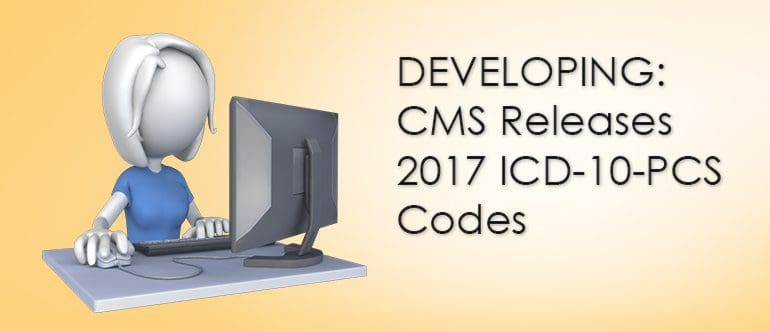Call us toll-free: 800-878-7828 — Monday - Friday — 8AM - 5PM EST

By Laurie M. Johnson, MS, RHIA, CPC-H, FAHIMA for ICD10 monitor
The Centers for Medicare and Medicaid Services (CMS) released the 2017 ICD-10-PCS codes as well as other supporting documentation on Thursday.
Before you get excited, the 2017 ICD-10-CM codes have not been released yet. The additional supporting documentation includes the 2017 ICD-10-PCS Official Coding and Reporting Guidelines, the addenda for the ICD-10-PCS Index and Tables, a text listing of the 2017 procedure codes with the file layout description, the order file which includes the long and short descriptions of the 2017 procedure codes, and a conversion table for the 2016 to 2017 codes.
The update also states that the following documents will not be updated beyond 2016: The ICD-10-PCS Reference Manual, the document describing the development of the ICD-10 Procedure Coding System (ICD-10-PCS), and the ICD-10 Procedure Coding System Power Point slides.
The long-awaited 2017 ICD-10-PCS codes are 75,789 in number. The new codes are found in the Medical and Surgical, Administration, Measurement and Monitoring, Extracorporeal Therapies, and New Technology sections. The highest number of changes is in the Medical and Surgical section, which now totals 65,676 codes. The Administration section has 39 changes, which increases the number of codes to 1,427. Extracorporeal Therapies section adds four new codes to increase the total to 46. The New Technology section has added 27 new codes which give us a glimpse into the procedures, devices, and substances that will be approved for New Technology add-on payments to MS-DRG v34.
The biggest changes include the revision of the definitions of root operations Control and Creation, new root operation “Perfusion,” which was added to the Extracorporeal Therapies section, and changing the body part terminology in the Heart and Great Vessels Body System. The coronary arteries will now be identified by the number of arteries treated and not sites. This change is supported in the 2017 ICD-10-PCS Coding and Reporting Guidelines. The new definition of Control is stopping, or attempting to stop, post-procedural or other acute bleeding. This revision now includes “other acute bleeding,” which may be based on the clinical documentation. The new definition of Creation is putting in or on biological or synthetic material to form a new body part that to the extent possible replicates the anatomic structure or function of an absent body part which has changed the focus of this root operation from only sex-change operations to operations in other body systems. The new root operation of Perfusion is defined as extracorporeal treatment by diffusion of therapeutic fluid.
The 2017 ICD-10-PCS Official Coding and Reporting Guidelines were developed based on the internal review of the 2016 version and public input. The areas that have been revised include B2.1a, B3.2, B3.4a, B3.6b, B3.6c, B3.7, B3.9, B4.2, and B4.4. Guideline B2.1a revision provides an alternative when clinical documentation is not present and the coder may use the general anatomic region as an unspecified code. The expectation is that this option will be used rarely. B3.2 (Multiple procedures) has been altered in the examples of this guideline. B3.4a adjusted the spacing for the provided examples. B3.6b and B3.6c adjusted the guideline to match the changes from coronary sites to coronary arteries in the Tables. B3.7 added “other acute bleeding” to reflect the change in the definition of root operation Control. B3.9 addresses the excision of an autograft. This guideline change provides more information to other body part value. This change includes “different procedure site” rather than other body part value. This revision will assist the coders to determine if a separate code should be reported. B4.2 adds information regarding cardiovascular structures that could have branches and how to assign a code when the specific artery or vein is not available in the correct table, but a general body part is available. The provided example of this guideline is the occlusion of the bronchial artery being coded to the body part value Upper Artery in the body system Upper Arteries, and not to the body part value Thoracic Aorta, Descending in the body system Heart and Great Vessels. Guideline B4.4 addresses coronary arteries as a body part value. As discussed earlier, coronary arteries as body parts are a big change for the 2017 version. The change involves a switch from the number of sites treated to the number of coronary arteries treated.
The first update to the ICD-10-PCS codes is finally here! The link to the new files for ICD-10-PCS is provided below. The industry continues to look for the 2017 ICD-10-CM codes and most importantly, MS-DRG v34.
Resources: https://www.cms.gov/Medicare/Coding/ICD10/2017-ICD-10-PCS-and-GEMs.html
